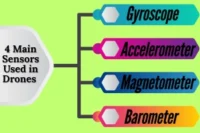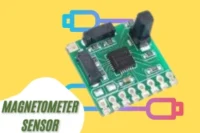How Drone Accelerometers Work to Keep Flight Stable
Published: 29 Jul 2025
The accelerometer sensor in drone technology is set to make drone flying even smarter. In the coming years, we will see drones that can balance better, fly smoother, and respond faster to movement. Why? Because accelerometers are becoming more accurate and responsive. These tiny sensors detect motion and help your drone know if it’s tilting, shaking, or accelerating. That means better control, even in tricky situations. Whether you fly drones for fun, farming, or filming, accelerometers will soon become the hidden hero behind safer flights. The future of drone stability starts with this small but powerful sensor.
What Is an Accelerometer Sensor
An accelerometer sensor in a drone is a small device that detects motion, speed, and tilt in all directions. It works like your inner ear, helping the drone stay balanced and upright during flight. Just like how you know when you are leaning forward or turning, the accelerometer tells the drone if it’s tilting, shaking, or moving fast. This sensor is usually placed inside the drone’s flight controller or the IMU (inertial measurement unit), where it constantly sends movement data to keep the drone steady. Without it, drones would struggle to hover, fly straight, or respond quickly to changes in direction.
How Accelerometers Work in Drones
Accelerometers help your drone understand how it moves through the air. They detect changes in speed and direction and send signals to keep the flight stable.
Detecting Movement
The accelerometer measures motion along three directions—side to side (X), forward and backward (Y), and up and down (Z). This helps the drone know exactly how it’s moving at any moment.
Helping the Flight Controller
When the accelerometer senses a change like a tilt or a sudden push, it quickly sends this data to the flight controller. The controller then adjusts the motor speeds to bring the drone back to balance.
The Power Behind This Small Sensor
The accelerometer may be small, but it plays a big role in making drone flights smooth, stable, and safe.
Stable Hovering
The accelerometer helps the drone stay still in the air when you’re not moving the controls. It constantly balances the drone to avoid drifting or wobbling.
Smooth Flying
It stops the drone from making sudden or jerky moves. This is especially useful when capturing video or flying in windy conditions.
Accurate Navigation
The sensor works with other systems to guide the drone along precise paths. It helps with obstacle avoidance, smooth turns, and soft landings.
Beginner-Friendly Handling
For new pilots, this sensor makes flying easier. It provides extra control and keeps the drone steady, even if you’re not perfect with the joystick.
How Accelerometers Are Evolving
Accelerometer technology is getting better with each new drone model. These upgrades are making drones smarter, quicker, and more reliable than ever before.
Smaller, Faster, More Accurate
New accelerometers are tiny but powerful. They can pick up even the slightest movements instantly, helping the drone react faster and stay more stable.
Working with Gyroscopes and GPS
Accelerometers now team up with other sensors like gyroscopes and GPS. Together, they create smarter navigation systems that improve flight paths and positioning.
Supports AI and Automation
Modern drones use accelerometers as part of automated flight systems. These sensors help drones make quick decisions on their own—perfect for delivery drones or self-flying drones.
Improving Every Year
With new tech developments, accelerometers are becoming more efficient. They use less power, weigh less, and work better in all types of environments.
What Happens If the Accelerometer Fails
If the accelerometer in your drone stops working, flight can quickly become unstable and risky. Here’s what you need to know and watch out for:
Loss of Stability
Without the accelerometer, your drone can’t keep itself balanced. It may drift, tilt on its own, or even crash if not corrected in time.
Warning Signs
Your drone might feel harder to control. You may notice wobbly flight, error lights on the controller, or app messages about sensor issues.
Basic Troubleshooting
Start by recalibrating the sensors using your drone’s app or controller. Restart the drone after calibration and test it again.
When to Get Help
If problems continue, don’t take chances. Contact the drone maker’s support team. They can guide you or suggest a repair.
Real-Life Applications
The accelerometer sensor in drones isn’t just for basic balance, it plays a key role in many real-world uses. Whether you are flying for fun or doing serious work.
Aerial Photography
When shooting photos or videos from the sky, stability is everything. The accelerometer keeps the drone steady, so you get smooth, shake-free footage—even during light wind or slight movements.
Agricultural Drones
In farming, drones scan large fields and collect data. The accelerometer helps these drones fly in straight lines and maintain a stable height, even during long, autonomous flights.
Delivery Drones
As drones carry packages from one place to another, their weight can shift. The accelerometer helps them adjust instantly to stay level and on course, ensuring safe delivery.
FPV and Racing Drones
In drone racing or freestyle flying, fast moves are everything. Accelerometers help these drones respond quickly during flips, rolls, and sharp turns, giving pilots better control and speed.
Conclusion
We have covered the accelerometer sensor in the drone in detail. My honest suggestion? Never overlook this tiny sensor—it’s a game-changer for both hobbyists and pros. If you want better control and fewer crashes, this is the tech you need to care about. Keep learning, keep flying.
FAQs
No, they are different but work together. An accelerometer measures straight-line movement, while a gyroscope tracks rotation. Together, they help keep the drone stable and responsive.
Most modern drones come with an accelerometer built-in. You can check your drone’s specs or manual to confirm.
Not at all, They are useful in racing, farming, inspections, and hobby flying too. Any drone that needs balance benefits from an accelerometer.
Yes, and they complement each other. GPS helps with location and altitude, while accelerometers track movement and balance. Together, they give your drone smart, safe control.





